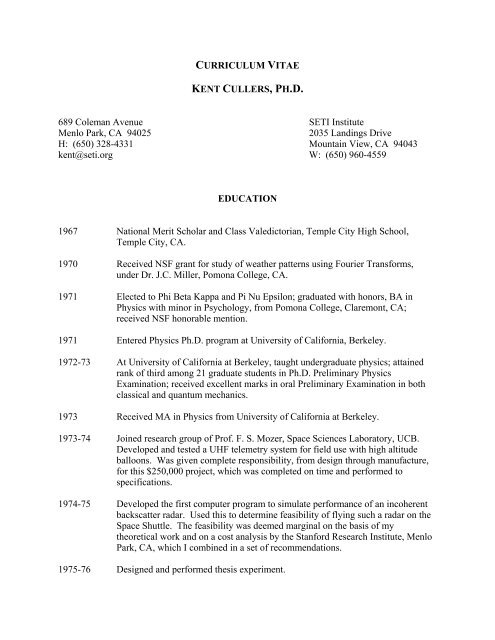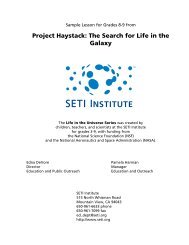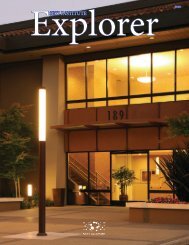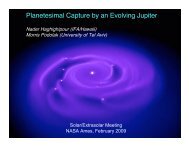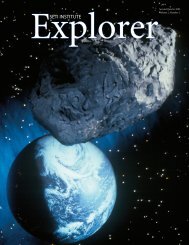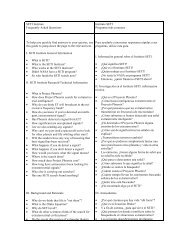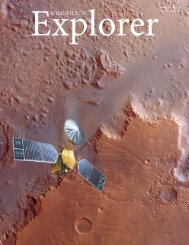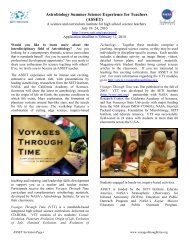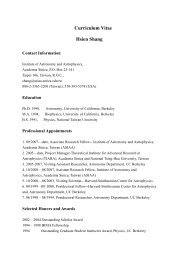CURRICULUM VITAE KENT CULLERS, PH.D. 689 ... - SETI Institute
CURRICULUM VITAE KENT CULLERS, PH.D. 689 ... - SETI Institute
CURRICULUM VITAE KENT CULLERS, PH.D. 689 ... - SETI Institute
Create successful ePaper yourself
Turn your PDF publications into a flip-book with our unique Google optimized e-Paper software.
<strong>CURRICULUM</strong> <strong>VITAE</strong><br />
<strong>KENT</strong> <strong>CULLERS</strong>, <strong>PH</strong>.D.<br />
<strong>689</strong> Coleman Avenue <strong>SETI</strong> <strong>Institute</strong><br />
Menlo Park, CA 94025 2035 Landings Drive<br />
H: (650) 328-4331 Mountain View, CA 94043<br />
kent@seti.org W: (650) 960-4559<br />
EDUCATION<br />
1967 National Merit Scholar and Class Valedictorian, Temple City High School,<br />
Temple City, CA.<br />
1970 Received NSF grant for study of weather patterns using Fourier Transforms,<br />
under Dr. J.C. Miller, Pomona College, CA.<br />
1971 Elected to Phi Beta Kappa and Pi Nu Epsilon; graduated with honors, BA in<br />
Physics with minor in Psychology, from Pomona College, Claremont, CA;<br />
received NSF honorable mention.<br />
1971 Entered Physics Ph.D. program at University of California, Berkeley.<br />
1972-73 At University of California at Berkeley, taught undergraduate physics; attained<br />
rank of third among 21 graduate students in Ph.D. Preliminary Physics<br />
Examination; received excellent marks in oral Preliminary Examination in both<br />
classical and quantum mechanics.<br />
1973 Received MA in Physics from University of California at Berkeley.<br />
1973-74 Joined research group of Prof. F. S. Mozer, Space Sciences Laboratory, UCB.<br />
Developed and tested a UHF telemetry system for field use with high altitude<br />
balloons. Was given complete responsibility, from design through manufacture,<br />
for this $250,000 project, which was completed on time and performed to<br />
specifications.<br />
1974-75 Developed the first computer program to simulate performance of an incoherent<br />
backscatter radar. Used this to determine feasibility of flying such a radar on the<br />
Space Shuttle. The feasibility was deemed marginal on the basis of my<br />
theoretical work and on a cost analysis by the Stanford Research <strong>Institute</strong>, Menlo<br />
Park, CA, which I combined in a set of recommendations.<br />
1975-76 Designed and performed thesis experiment.
1976 Passed Ph.D. Qualifying Examination with concentrations in information theory,<br />
plasma physics, and magnetospheric and ionospheric physics.<br />
1978 Operated radar at Chatanika, Alaska, during a five day international ionospheric<br />
study.<br />
1980 Thesis accepted (Altitude Dependence of the Radar Measured Perpendicular<br />
Electric Field With Evaluation of Statistical Uncertainties and Systematic Errors).<br />
Received Ph.D. from the University of California, Berkeley.<br />
PROFESSIONAL EXPERIENCE<br />
5/80 - 11/82 National Research Council Research Associate at NASA-Ames Research Center,<br />
in the <strong>SETI</strong> R&D Office of the Extraterrestrial Research Division of the Office of<br />
Life Sciences; research in information theory and signal processing; guiding a<br />
team tackling frontier problems arising in Project <strong>SETI</strong>, the Search for<br />
Extraterrestrial Intelligence.<br />
11/82 - 2/85 Associate Research Scientist under a NASA cooperative agreement to the<br />
Frederic Burk Foundation. During this period developed the first detector for<br />
regularly spaced narrow-band pulses. With the help of other team members,<br />
simulated detection behavior and calculated sensitivity.<br />
2/85 - 1/90 Signal Detection Team Leader for the <strong>SETI</strong> <strong>Institute</strong> under a NASA cooperative<br />
agreement. Developed, evaluated and implemented optimized detection<br />
algorithms for slowly drifting CW and regularly spaced narrow-band pulses.<br />
Developed highly sensitive computationally intensive algorithms as well as<br />
slightly less sensitive computationally small algorithms suitable for commercially<br />
available hardware. Developed new calculational methods to optimize<br />
computational speed and memory use and to evaluate sensitivities.<br />
2/90 - 2/94 Signal Detection Subsystem Manager and Mathematician at NASA Ames<br />
Research Center. Supervised the development of hardware and software for<br />
signal detection in NASA’s High Resolution Microwave Survey (HRMS) Project.<br />
Production of this subsystem required mathematical calculation, software<br />
development, system engineering, and system integration skills. From 1993 to<br />
March 1994 led the <strong>SETI</strong> R&T effort. Managed the upgrading and replication of<br />
all the digital data processing equipment for HRMS. NASA’s HRMS Project was<br />
cancelled by Congress in October 1993, but is still participating in Project<br />
Phoenix, the <strong>SETI</strong> <strong>Institute</strong>’s continuation of the Targeted Search portion of<br />
HRMS. Also involved with the Theoretical Astrophysics Branch at NASA Ames.<br />
3/94 - 9/95 Developed techniques for the photometric detection of Earth-sized planets in the<br />
Theoretical Astrophysics Branch at NASA Ames.<br />
12/3/2003<br />
2
10/95 - 5/96 Acting Director, Project Phoenix<br />
5/96 - 6/99 Project Manager for the <strong>SETI</strong> <strong>Institute</strong>’s Project Phoenix.<br />
6/99 - Director, <strong>SETI</strong> R&D, <strong>SETI</strong> <strong>Institute</strong><br />
ADDITIONAL AREAS OF PROFESSIONAL COMPETENCE<br />
Computer languages; FORTRAN, BASIC, PLI, PASCAL, C.<br />
Computer operating systems; RSX-11M, UNIX, OASIS.<br />
National Merit Scholar, 1967<br />
OTHER ACTIVITIES AND AWARDS<br />
North American Rockwell Management Club Scholar, 1967<br />
Phi Beta Kappa, 1971<br />
National Science Foundation Honorable Mention for Scholastic Achievement, 1971<br />
National Federation of the Blind, National winner, Scholarship for graduate achievements in<br />
science and medicine, 1972<br />
Board member, San Francisco Lighthouse for the Blind and Visually Impaired<br />
Member AAS<br />
Member of AAAS panel for Handicapped Scientists and Engineers<br />
Chairman, Committee on Opportunities in Science, AAAS<br />
NASA special achievement award, 1992<br />
NASA Exceptional Engineering Achievement medal, 1993<br />
Federal Employee of the Year, 1994<br />
Member, Board of Trustees for Sensory Access Foundation, 1998 -<br />
Member, Board of Trustees for Peninsula Center for the Blind & Visually Impaired, 2000 -<br />
PERSONAL DATA<br />
12/3/2003<br />
3
Birth: El Reno, Oklahoma, 7/21/49<br />
Citizenship: USA<br />
Marital Status: Married, two children.<br />
NONPROFESSIONAL INTERESTS<br />
Chess, Medicine, Music (Piano and Guitar), Ham Radio (WA6TWX since 1961)<br />
PUBLICATIONS<br />
D K. Cullers, M.C. Kelley, and F.S. Mozer, “Parallel and Altitude Dependent Perpendicular<br />
Electric Fields Deduced from Auroral Zone Incoherent Scatter Measurements.” EOS (AGU<br />
Trans.), Vol. 54, No. 11, p. 1173, #SM 17 (Nov. 1973).<br />
D.K. Cullers, F.S. Mozer, C.L. Rino, and V.B. Wickwar, “Simulation of the Statistics of a Signal<br />
Backscattered from an Ionosphere with Uniform Physical Properties.” EOS (AGU Trans.),<br />
Vol. 56, No. 12, p. 1053, #SM 93, (Dec. 1975).<br />
D.K. Cullers and F.S. Mozer, “Feasibility of Coherent and Incoherent Backscatter Experiments<br />
from the AMPS Laboratory.” Report under NASA Contract NAS 8-31346 (1976).<br />
R.H. Holzworth, J.J. Bertheilier, U.V. Fahleson, C.G. Halthammer, P.J. Kellogg, P. Tanskanen,<br />
D.K. Cullers, M.K. Hudson, M.C. Kelley, M. Temerin, and F.S. Mozer, “The Large Scale<br />
Ionospheric Electric Field: Its Variation with Magnetic Activity and Relation to Terrestrial<br />
Kilometric Radiation.” J. Geophys. Res., No. 19, p. 2735 (1977).<br />
D.K. Cullers, “Altitude Dependence of the Radar Measured Perpendicular Electric Field with<br />
Evaluation of Statistical Uncertainties and Systematic Errors.” Thesis, University of California<br />
at Berkeley (May 1980).<br />
D.K. Cullers and S. Rathjen, “Ultimate QSO.” QST (Dec. 1982).<br />
D.K. Cullers, B.M. Oliver, and E.T. Olsen, “Signal Recognition.” Report of the <strong>SETI</strong> Science<br />
Working Group, Appendix III (1983).<br />
12/3/2003<br />
4
D.K. Cullers, “Amateur <strong>SETI</strong> Workshop: Extraterrestrial Signal Detection,” AstroSearch, Vol.<br />
1, No. 1 (March-April 1983).<br />
D.K. Cullers, “Data Averaging and the Normal Curve,” AstroSearch, Vol. 1, No. 2 (May-June<br />
1983).<br />
D.K. Cullers, “Intergalactic Communication or Altruism and the Selfish Gene,” AM<strong>SETI</strong><br />
Workshop, AstroSearch, Vol. 1, No. 3 (July-August 1983).<br />
D.K. Cullers, “Software Implementation of Detection Algorithms for the MCSA.” The Search<br />
for Extraterrestrial Life: Recent Developments, International Astronomical Union Symposium<br />
112 (1985).<br />
D.K. Cullers, I.R. Linscott and B.M. Oliver, “Signal Processing in <strong>SETI</strong>.” Communications of<br />
the ACM, ACM/IEEE-CS Joint Issue, Vol. 28, No. 11 (Nov. 1985).<br />
D.K. Cullers, “Sensitive Detection of Narrowband Pulses.” Acta Astronautica, Vol. 13, No. 1,<br />
pp. 31-37 (1986).<br />
D.K. Cullers and S.R. Deans, “Narrowband Signal Detection in the <strong>SETI</strong> Field Test.” The<br />
Search for Extraterrestrial Intelligence, NRAO Workshop Proceedings (1986).<br />
D.K. Cullers, “Three Pulse and Multiple Stage Continuous Wave Detection Algorithms.”<br />
Conference proceedings of the IAU Colloquium 99, Bioastronomoy-The Next Steps, G. Marx,<br />
(ed.) pp. 371-376 (1988).<br />
J.C. Tarter, P.R. Backus, D.K. Cullers, J. Dreher, “A Search for Single Mode Emission from<br />
Saturated Astronomical OH Masers(a).” AAS Bulletin, Vol. 21, No. 4 (1990).<br />
J.C. Tarter, D.K. Cullers, P.R. Backus, S. Gulkis, E.T. Olsen, E. . Jackson, J. Dreher, D.<br />
Werthimer, W. Herrick, and J. Jordan, “An Attempt to Characterize RFI at Arecibo for Future<br />
<strong>SETI</strong> Observations.” URSI Meeting (Jan. 1990).<br />
D.K. Cullers and W.R. Alschuler, “Chapter Nine: How to Participate in <strong>SETI</strong>.” First Contact,<br />
Chapter Nine, B. Bova and B. Preiss (eds.), Byron Preiss Visual Publications, Inc., pp. 279-301<br />
(1990).<br />
J.C. Tarter, P.R. Backus, D.K. Cullers, J. Dreher, C. Hlavka, J. Jordan, “Trying to do Science<br />
Using High Spectral Resolution <strong>SETI</strong> Prototypes.” Lecture Notes in Physics, 390,<br />
Bioastronomy: The Search for Extraterrestrial Life, J. Heidmann and M.J. Klein (eds.).<br />
Poster paper presented at the 3rd Bioastronomy Symposium, in Val Cenis, France (1990).<br />
D.K. Cullers, “<strong>SETI</strong> Project to Build Largest Search System.” Online (a publication of the Ames<br />
Computer Systems and Research Division), Vol. 12, No. 12 (Dec. 1990).<br />
S.R. Deans and D.K. Cullers, “Tables of Square-Law Signal Detection Statistics for Hann<br />
Spectra with 50% Overlap.” NASA Technical Memorandum #103830, (Sept. 1991).<br />
12/3/2003<br />
5
S.R. Deans, D.K. Cullers, and R.P. Stauduhar, “Computational Problems and Signal Processing<br />
in <strong>SETI</strong>.” Maximum Entropy and Bayesian Methods, W. T. Grandy, Jr. and L. H. Schick<br />
(eds.), Kluwer Academic Publishers, Dordrecht, pp. 67-75 (1991).<br />
S.R. Deans and D.K. Cullers, “Statistics of Overlapped Processing with Shaped Windows.”<br />
Submitted to IEEE November 1993.<br />
D.K. Cullers, “An Application of One Measure of Search Merit to Optical <strong>SETI</strong>.” The Search<br />
for Extraterrestrial Intelligence (<strong>SETI</strong>) in the Optical Spectrum, Proceedings Vol. 1867, S.<br />
Kingsley (ed.), SPIE—The International Society for Optical Engineering, Bellingham, pp. 156-<br />
160 (1993).<br />
D.K. Cullers, “A New Method for Determining the Merits of <strong>SETI</strong> Search Strategies.” Third<br />
Decennial US-USSR Conference of <strong>SETI</strong>. S. Shostak (ed.), Astronomical Society of the<br />
Pacific Conference Series, Vol. 47, San Francisco, pp. 67-72 (1993).<br />
J.M. Jenkins, L.R. Doyle, and D.K. Cullers, “A Matched Filter Method for Ground-Based Sub-<br />
Noise Detection of Extrasolar Planets in Eclipsing Binaries: Application to CM Draconis.”<br />
Icarus, Vol. 119, p. 244 (1996).<br />
E. Pardo and D.K. Cullers, “Design of the Fast Fourier Transform Board in the <strong>SETI</strong> Follow Up<br />
Detection Device.” 45th Congress of the IAF, Jerusalem, Israel (Oct. 1994). To be published<br />
in Special Issue of Acta Astronautica. J. Heidmann (ed.) (1996).<br />
D.K. Cullers, “Parallel Processing in the Search for Extraterrestrial Intelligence.” Frontier<br />
Science in EEG: Continuous Waveform Nanlysis (EEG Suppl. 45). R.M. Dashiff and D.J.<br />
Vncent (eds.), Elsevier Science B.V., pp. 123-133 (1996).<br />
D.K. Cullers and R. P. Stauduhar, “Follow-Up Detection in Project Phoenix.” Astronomical and<br />
Biochemical Origins and the Search for Life in the Universe, C.B. Cosmovici, S. Bowyer and<br />
D. Werthimer (eds.), Editrice Compositori, Bologna, Italy, pp. 645-651 (1997).<br />
J.W. Dreher and D.K. Cullers, “<strong>SETI</strong> Figure of Merit.” Astronomical and Biochemical Origins<br />
and the Search for Life in the Universe, C.B. Cosmovici, S. Bowyer and D. Werthimer (eds.),<br />
Editrice Compositori, Bologna, Italy, pp. 711-717 (1997).<br />
J.J. Heine, S.R. Deans, D.K. Cullers, R. Stauduhar, and L.P. Clarke, “Multiresolution Statistical<br />
Analysis of High-Resolution Digital Mammograms.” IEEE Transactions on Medical Imaging,<br />
Vol. 16, No. 5, pp. 503-515 (October 1997).<br />
J.J. Heine, S.R. Deans, D.K. Cullers, R. Stauduhar, and L.P. Clarke, “Multiresolution Probability<br />
Analysis of Gray-Scaled Images.” Journal of the Optical Society of America, Vol. 15, No. 5,<br />
pp. 1048-1058 (May 1998).<br />
12/3/2003<br />
6
D.K. Cullers, Are We Alone in the Cosmos? The Search for Alien Contact in the New<br />
Millennium. Ben Bova and Byron Preiss, eds., pp. 222-225; 240-262, ibooks, New York<br />
(1999).<br />
D.K. Cullers, “Project Phoenix and Beyond.” Bioastronomy '99 - A New Era in Bioastronomy,<br />
Proceedings of a Conference held on the Kohala Coast, Hawaii, 2-6 Aug. 1999, ASP<br />
Conference Series Vol. 213, p. 451-458 (2000).<br />
T. Pierson, J. Billingham, and D.K. Cullers, “<strong>SETI</strong> 2020 – A Roadmap for the Next Twenty<br />
Years of <strong>SETI</strong> Research.” Presented at 51 st IAF Congress, Rio de Janeiro, Brazil (Oct. 2-6,<br />
2000). To be published in special edition of Acta Astronautica.<br />
M-E. Schlumberger and D.K. Cullers, “The <strong>SETI</strong> Game.” Paper #IAA-010IAA.9.1.11 presented<br />
at the 52 nd IAF Congress, Toulouse, France (Oct. 2001). To be published in special edition of<br />
Acta Astronautica.<br />
R. Ekers, D.K. Cullers, J. Billingham, and L. Scheffer (eds.), <strong>SETI</strong> 2020, A Roadmap for the<br />
Search for Extraterrestrial Intelligence, <strong>SETI</strong> Press, Mountain View (2002).<br />
D.K. Cullers, “Trials of Omni-Directional Sky Survey Telescopes.” Paper #IAC-02-IAA.9.1.05<br />
presented at the World Space Congress, IAA.9.1. Joint Session with COSPAR on <strong>SETI</strong> I -<br />
New <strong>SETI</strong> Facilities Enlarge the Search, Houston, Texas (Oct. 2002).<br />
D.K. Cullers, Detection and Decoding of Information-Dense Signals,” in Between Worlds: The<br />
Art and Science of Interstellar Message Composition. D.A. Vakoch (ed.), MIT Press,<br />
Cambridge (in press, Nov. 2003).<br />
12/3/2003<br />
7
IN PREPARATION<br />
D.K. Cullers, “Going Commercial: Finding the Signal in the Targeted Search,” to be published<br />
in proceedings from the Planetary Society Conference on <strong>SETI</strong>, Toronto, Canada.<br />
D.K. Cullers and F.S. Mozer, “Deduction of a Lower Bound for the Long-time-average Parallel<br />
Electric Field in the Earth’s Northern Auroral Zone During Magnetically Active Times.”<br />
D.K. Cullers, “One Bit Sampling Theorem and Drifting CW Detection.”<br />
D.K. Cullers, C.L. Rino, and F.S. Mozer, “Statistical Uncertainties of Incoherent Backscatter<br />
Estimates of Densities and Velocities.”<br />
D.K. Cullers and F.S. Mozer, “Spectral Asymmetries Caused by Finite Sample Rates and Their<br />
Implications for Radar Velocity Measurement.”<br />
C.L. Rino and D.K. Cullers, “A Correction to the Derivation of the Covariance of Two Signal<br />
Auto-correlation Functions.”<br />
D.K. Cullers, “One Comparison of Past and Future <strong>SETI</strong> Searches.”<br />
12/3/2003<br />
8


